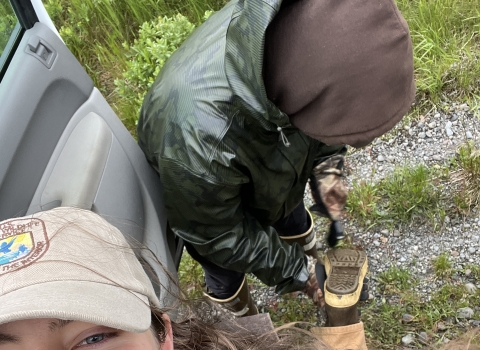Mature forests, grassland meadows, uninterrupted sandy beaches — these could be snapshots from a national wildlife refuge national wildlife refuge
A national wildlife refuge is typically a contiguous area of land and water managed by the U.S. Fish and Wildlife Service for the conservation and, where appropriate, restoration of fish, wildlife and plant resources and their habitats for the benefit of present and future generations of Americans.
Learn more about national wildlife refuge in the Mid-Atlantic region.
But they’re also the kinds of habitat protected on military lands in this part of the country.
Military installations encompass natural resources that attract and support a diversity of wildlife species, including some that are federally listed as endangered or threatened, and some that are at risk of declines.
In recent years, natural resource managers at Naval installations in Delaware, Maryland, and Washington, D.C., have noted the presence of migrating monarch butterflies, a candidate for listing on the Endangered Species Act.
Monarch numbers in North America have declined in the past two decades, prompting the U.S. Fish and Wildlife Service to step up proactive efforts to improve the species’ status, including by gathering information that can guide strategic conservation measures.
Biologist Sabrina Deeley from the Service’s Chesapeake Bay Field Office recognized an opportunity to advance this work on military lands.
Deeley reached out to natural resource managers on Naval installations in the Mid-Atlantic region and proposed working together to tag monarch butterflies during their annual migration south to wintering habitat in Mexico.
The blue and gold look out for the orange and black
After receiving an overwhelmingly enthusiastic response, staff set out to equip Naval installations with the knowledge and tools to help track these iconic orange and black butterflies.
It started at Naval Support Activity Annapolis in Maryland—across the Severn River from the U.S. Naval Academy—where Service biologist Peter McGowan demonstrated how to safely capture, handle, tag, and release these delicate creatures.
To expand the geographic footprint of the survey effort, Service staff also led trainings for staff from two other installations in southern Maryland — Naval Support Facility Indian Head and Naval Air Station Patuxent River — and lent equipment to personnel so they could opportunistically tag monarchs on their own.
Deeley explained that the Service is also working with installations to increase the quantity and quality of pollinator habitat to support monarchs and other at-risk species.
“More important than the actual numbers of butterflies tagged, is the emphasis on monitoring and maintaining monarch habitat throughout the region to support the monarch’s complex life cycle,” Deeley said. “By partnering with Naval installations, we can gather valuable data on when and where monarchs show up that will help us take strategic action to enhance their habitat. We hope this partnership continues to flourish into the future.”
It’s a win-win for the Service and the Navy. On the nearly 30 million acres it manages, the Department of Defense has a dual mandate to protect wildlife and national security. Because maintaining ecological and biological diversity helps these lands withstand natural and manmade disturbances, it’s considered critical for military preparedness as well.
“Working with the U.S. Fish and Wildlife Service for this survey is nothing but positive for everyone, and every bug, involved. Military preparedness and biological security have a close relationship, and the Navy understands the responsibility involved in both,” said Katherine Seguin, Naval Support Activity Annapolis natural resource manager. "Knowing what lives and thrives on our lands is essential to training and supporting the young minds of the Naval Academy to see the greater picture of the world around them.”
The Chesapeake Bay Field Office plans to extend monarch training and technical assistance to other Department of Defense lands in the region, including U.S Army and U.S. Air Force installations, in 2023.






